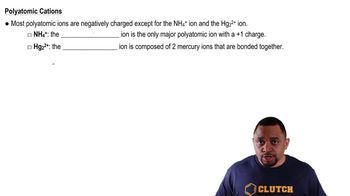Here are the essential concepts you must grasp in order to answer the question correctly.
Atomic Structure
Atoms consist of protons, neutrons, and electrons. Protons are positively charged particles found in the nucleus, while electrons are negatively charged and orbit the nucleus. The number of protons defines the element, and in a neutral atom, the number of electrons equals the number of protons.
Recommended video:
Ionic Charge
Ions are atoms that have gained or lost electrons, resulting in a net charge. A positive charge indicates that an atom has lost electrons, while a negative charge indicates that it has gained electrons. For tin(IV), the 'IV' signifies that the tin ion has lost four electrons, resulting in a +4 charge.
Recommended video:
Tin(IV) Ion
The tin(IV) ion specifically refers to the tin ion with a +4 charge, meaning it has four fewer electrons than its neutral state. Tin has an atomic number of 50, which means a neutral tin atom has 50 protons and 50 electrons. Therefore, the tin(IV) ion has 50 protons and 46 electrons.
Recommended video:
 Verified step by step guidance
Verified step by step guidance Verified video answer for a similar problem:
Verified video answer for a similar problem:



 1:24m
1:24m